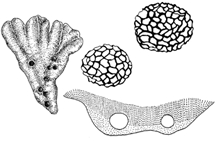Bryophyte
Bryophyte a division of the plant kingdom which includes the simplest and the most primitive of the green land plants, numbering about 24,000 species. This group is generally divided into three classes: Hepaticae or Hepaticopsida (liverworts and scale mosses), Anthocerotae or Anthocerotopsida (hornworts), and Musci or Bryopsida (mosses). Recently these classes are often treated as divisions.

Bryophytes are widely distributed throughout the world from the polar regions to the tropics, including Bangladesh and are most abundant in humid environments. They favour moist, shady places; a few grow on arid sites and some are aquatic, but none is marine. Most bryophytes are small, usually 2 to 5 cm tall; the smallest one in Bangladesh is about 4 mm, and a few are more than 30 cm long.
Bryophytes display a distinct alternation of sexual and asexual generations. The sexual gametophyte with a haploid chromosome number is more conspicuous, longer-lived, and more diversified, compared with the diploid sporophyte generation which is reduced in size, short-lived, and structurally attached to the gametophyte, and partially or completely dependant on it.
The gametophyte plant body is either a flattened thallus or leafy shoot. In the latter case the main shoot (or caulid) bears lateral flattened leaves (or phylid). Leaves and stems are usually simple. The gametophyte of bryophytes do not have roots but are generally attached to the substratum by means of unicellular or multicellular branched or unbranched hair-like rhizoids which are not necessarily absorptive but do influence water and mineral uptake. Vascular tissue is totally absent or very rudimentary with no lignification of cells.
Bryophytes are less economically important than other land plants except the peat moss Sphagnum, which has some medicinal value. Some are used ornamentally. They have indirect use in the formation of soil and rock, in vegetation cover and soil conservation, and act as a pioneer plant in plant succession.
Bangladesh, being a sub-tropical country with hot, humid, rainy summer and mild, dry winter has a luxuriant growth of bryophytes. They are found in different parts of the country, especially growing on hills and in forests throughout the year. The bryophytes of Bangladesh belong to three classes, 14 orders, 34 families, 92 genera and about 247 species including four varieties. Amongst these mosses are most prevalent.
Based on the information collected from different districts of Bangladesh it is evident that bryophytes are fairly common and adapted to a wide range of habitats and their distribution pattern is varied. They are most abundant in damp, shaded soils of hills and forests, on the slopes, floors and also along the sides of streams and 'chharas'. They are present in the eastern, northeastern and northern regions especially in Cox's Bazar, Chittagong, Bandarban, Rangamati, Khagracchari, Sylhet, Maulvi Bazar, Habiganj, Mymensingh and Sherpur districts. Terrestrial mosses are less abundant in the southern areas, especially near the coast of the bay of bengal, though some are abundant on damp bricks, walls and roofs; some are epiphyllous or epiphytes. The central and western parts of Bangladesh have a moderate assemblage of bryophytes; although found in different habitats, only two bryophytes are known to be aquatic and none is marine.
Among the hepatis genera growing on soil, old damp bricks and walls, Riccia, Marchantia, Cyathodium, Dumortiera, Pallavicinia, Plagiochasma, and Chiloschyphus are common. Lejeunea, Frullania and Jungermannia are common epiphytes. Ricciocarpus natans and Riccia fluitans are the only two aquatic hepatics reported so far from Bangladesh.
Representatives of the class Anthocerotopsida, Anthoceros and Notothylas are usually found on soils along the 'chharas', streams and rivers or on very damp and shaded soil.
Semibarbula orientalis and Hyophila involuta growing on walls and bricks and Calymperes, Taxithelium and Erpodium growing on the bark of trees are some of the common mosses of Bangladesh. Other common mosses are Fissidens, Bryum, Splachnobryum, Hydrogonium, Physcomitrium, Philonotis, Garckea, Gymnostomiella, Leucophanes, Octoblepharum, Isopterigium, Vesicularia, Glossadelphus, and Plagiothecium. [Khurshida Banu-Fattah]
